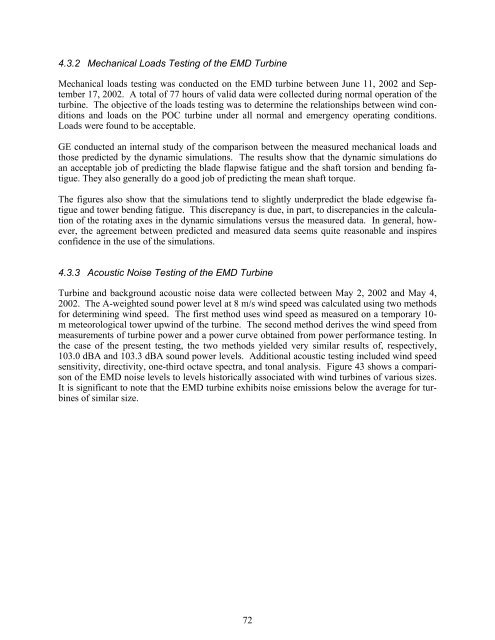Advanced Wind Turbine Program Next Generation Turbine ... - NREL
Advanced Wind Turbine Program Next Generation Turbine ... - NREL
Advanced Wind Turbine Program Next Generation Turbine ... - NREL
Create successful ePaper yourself
Turn your PDF publications into a flip-book with our unique Google optimized e-Paper software.
4.3.2 Mechanical Loads Testing of the EMD <strong>Turbine</strong><br />
Mechanical loads testing was conducted on the EMD turbine between June 11, 2002 and September<br />
17, 2002. A total of 77 hours of valid data were collected during normal operation of the<br />
turbine. The objective of the loads testing was to determine the relationships between wind conditions<br />
and loads on the POC turbine under all normal and emergency operating conditions.<br />
Loads were found to be acceptable.<br />
GE conducted an internal study of the comparison between the measured mechanical loads and<br />
those predicted by the dynamic simulations. The results show that the dynamic simulations do<br />
an acceptable job of predicting the blade flapwise fatigue and the shaft torsion and bending fatigue.<br />
They also generally do a good job of predicting the mean shaft torque.<br />
The figures also show that the simulations tend to slightly underpredict the blade edgewise fatigue<br />
and tower bending fatigue. This discrepancy is due, in part, to discrepancies in the calculation<br />
of the rotating axes in the dynamic simulations versus the measured data. In general, however,<br />
the agreement between predicted and measured data seems quite reasonable and inspires<br />
confidence in the use of the simulations.<br />
4.3.3 Acoustic Noise Testing of the EMD <strong>Turbine</strong><br />
<strong>Turbine</strong> and background acoustic noise data were collected between May 2, 2002 and May 4,<br />
2002. The A-weighted sound power level at 8 m/s wind speed was calculated using two methods<br />
for determining wind speed. The first method uses wind speed as measured on a temporary 10m<br />
meteorological tower upwind of the turbine. The second method derives the wind speed from<br />
measurements of turbine power and a power curve obtained from power performance testing. In<br />
the case of the present testing, the two methods yielded very similar results of, respectively,<br />
103.0 dBA and 103.3 dBA sound power levels. Additional acoustic testing included wind speed<br />
sensitivity, directivity, one-third octave spectra, and tonal analysis. Figure 43 shows a comparison<br />
of the EMD noise levels to levels historically associated with wind turbines of various sizes.<br />
It is significant to note that the EMD turbine exhibits noise emissions below the average for turbines<br />
of similar size.<br />
72
















